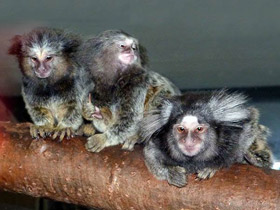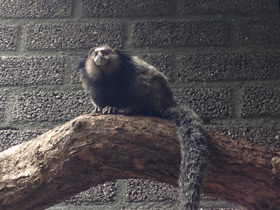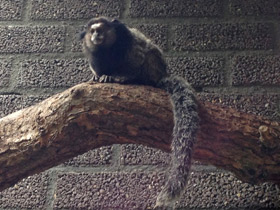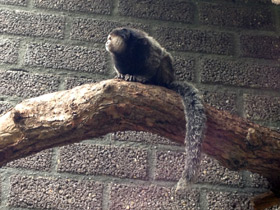The black-tufted marmoset (Callithrix penicillata), Mico-estrela
The black-tufted marmoset (Callithrix penicillata), also known as Mico-estrela in Portuguese, is a species of New World monkey that lives primarily in the Neo-tropical gallery forests of the Brazilian Central Plateau. It ranges from Bahia to Paraná, and as far inland as Goiás, between 14 and 25 degrees south of the equator, and can commonly be seen in the City of Rio de Janeiro where it was introduced. This marmoset typically resides in rainforests, living an arboreal life high in the trees, but below the canopy. They are only rarely spotted near the ground.
Appearance and habitat
Callithrix penicillata, popularly known as myco-strella, is a species of platyrrhine primate of the family Callitrichidae.
Callithrix penicillata closely resembles common Toynas, but differs from them by the shorter, black ear tufts and alternating black and brown transverse stripes on the body. The body length of these monkeys varies between 18 and 30 cm, the tail length between 17 and 40 cm and the weight between 300 and 450 g.
This species is found in the forests of Brazil. Callithrix penicillata are often found near human settlements and running towards plantations.
Behavior
Diurnal and arboreal, the black-tufted marmoset has a lifestyle very similar to other marmosets. It typically lives in family groups of 2 to 14. The groups usually consist of a reproductive couple and their offspring. Twins are very common among this species and the males, as well as juvenile offspring, often assist the female in the raising of the young.
Though the black-tufted marmoset lives in small family groups, it is believed that they share their food source, sap trees, with other marmoset groups. Scent marking does occur within these groups, but it is believed that the marking is to deter other species rather than other black-tufted marmoset groups, because other groups typically ignore these markings. They also appear to be migratory, often moving in relation to the wet or dry seasons, however, the extent of their migration is unknown.
Though communication between black-tufted marmosets has not been studied thoroughly, it is believed that it communicates through vocalizations. It has known predator-specific cries and appears to vocalize frequently outside of predator cries.
Food and predation
The black-tufted marmoset diet consists primarily of tree sap which it gets by nibbling the bark with its long lower incisors. In periods of drought, it will also include fruit and insects in its diet. In periods of serious drought it has also been known to eat small arthropods, molluscs, bird eggs, baby birds and small vertebrates.
Large birds of prey are the greatest threat to the black-tufted marmoset, however, snakes and wild cats also pose a danger to them. Predator-specific vocalizations and visual scanning are its only anti-predation techniques.
Ecosystem roles and conservation status
The black-tufted marmoset is a mutualist with many species of fruit trees because it distributes the seeds from the fruit it consumes throughout the forests. However, it is a parasite on other species of trees because it creates sores in trees in order to extract sap, while offering no apparent benefit to the trees. Though this marmoset is not a main food source to any specific species, it is a food source to a number of different species, specifically large birds of prey, wild cats, and snakes.
The black-tufted marmoset is listed as having no special status on the IUCN Red List or the United States Endangered Species Act List. It is listed in Appendix II of CITES and is not currently considered an endangered or threatened species. In Rio de Janeiro State, where it was introduced alongside the common marmoset, it is considered as an invasive species posing a danger to the survival of the endangered golden lion tamarin through competition. Management of the species in its invaded habitat has included proposals for sterilization of reproductive-age individuals, relocation, and public awareness campaign for prevention of further releases.
Reproduction
Callithrix penicillata live in family groups of 4 to 15 individuals. The group consists of a breeding pair and subordinate animals. The young are cared for by both parents and the rest of the group.
Females give birth to young at any time of the year, their pregnancy lasting 140-150 days. Normally the female gives birth to two cubs. She carries them on her belly for the first week and then the father and other members of the family group carry them on their backs. The female only takes the cubs to feed them (approximately every 2-3 hours). She feeds the cubs with milk for about two months.















































